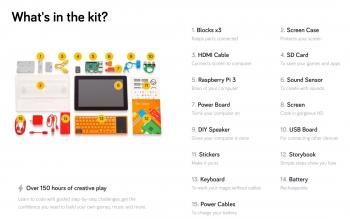Kano? Can! Yes! We Can Build Computers!

- School:
- Tommie Barfield Elementary
- Subject:
- Technology
- Teacher:
- Jody McCarty
- Students Impacted:
- 270
- Grade:
- K-5
- Date:
- July 8, 2018
Investor
Thank you to the following investor for funding this grant.
Suncoast Credit Union - $1,999.00
Original Grant Overview
Goal
Goals: My students will learn to create technology, not just consume it. Through this project, students learn to build a real, working computer. Students learn to identify, assemble, and use the following parts of a Computer:
*Hardware - screen, screen case, HDMI Cord, SD Card, Raspberry Pi (processor), keyboard, sound sensor and speakers, power board with rechargeable battery and outlet cord plug, and USB Board.
*Software - Programs with activities that the run on the computer. Kano Computer Kits contain a plethora of software that provide students with over 150 Software Coding activities focused on creativity.
*Operating System - the software that makes the computer work. Kano Computer Kits come with their own Operating System on the SD Card.
Students learn to disassemble, or unbuild, the Kano computer.
Through this project, students learn to program, or write code for, the computer they built. Code is the language of computer software. With Kano Computer Kits, students learn to write computer programming code in two ways: blocks and text. Once students code the steps they want, it's called a program.
Block code is similar to puzzle pieces that lock together. Each block already contains a different command, such as “Move forward”.
Script code is when a direction is written out in text, such as: “Forward” “Twenty” to move an object twenty pixels.
What will be done with my students
First, students build a complete working computer, supporting each other cooperatively, as they work in partners or small groups. Students start by unpacking and identifying all of the necessary hardware parts (see included picture). Students follow step-by-step instructions, written in simple text with clear illustrations (similar to LEGO instruction manuals so very familiar to most students), to completely assemble the computer.
Second, once the computer is built, students learn to install and activate the Kano Operating System (OS). This is an OS developed specifically for the Kano devices using the Raspberry Pi processor. The Kano OS is installed from a small SD Card contained in the kit. Students follow on-screen prompts to install, load, and run the Kano OS, thus making the Kano Computer fully functional. Next, students create their own Kano accounts, where their progress and activities can be saved for continuous progress.
Third, students learn to write code for software, or apps (applications), that come as part of the Kano computer. Students follow on-screen prompts that teach the students the beginning of both block code and script code. Some of the coding languages students learn through the Kano apps are: Scratch (which I introduced to my students last school year, so this would be an expansion / application of those skills learned), Coffeescript (APP: Make Art), Kano Blocks (APP: Hack Minecraft) and Python (Make Pong), along with others like: HTML, Javascript, Swift, and CSS. If these sound like foreign languages to you, that’s okay! You have most likely used devices and websites written in these coding languages. The difference with Kano is the students learn not just to use technology but to create it!
Each Kano app contains three learning levels for students. The apps start with simple-to-follow Tutorials that guide students with step-by-step instructions. Students learn the basics of the code languages through these app Tutorials, starting at the bottom of the higher-order thinking skills pyramid with remembering and understanding. Each Kano app has a Challenge List, which gives students the beginnings of puzzles and situations that are open-ended, encouraging them to apply what they’ve learned in the tutorials to complete the Challenge uniquely. This level provides opportunities for students to move up the pyramid of higher-order thinking to understanding, applying, and analyzing. Finally, each app has a Playground, in which the students are given the blank canvas on which to use their code skills to develop their own creative projects. This is where students apply higher-order thinking skills, such as applying, analyzing, evaluating, and at the pinnacle: creating. The Kano apps cover the span of classroom curriculum in that students are reading, writing, and communicating (English Language Arts or ELA), Math, Art, Music, Science, and Social Studies.
Here are some examples of how the Kano computer teaches students the different coding languages through the use of some classic and well-known video games like Pong and Paint. Kano teaches the students how to write the text-based coding language called Python to change, or “Hack” the Pong game. For Pong, students learn to change: the background or setting - it could become Outer Space or the Rainforest. The Pong ball can become a basketball or a beachball of many different sizes and colors. The Pong Paddles can be made any color and line style the students choose. Very different from the classic Pong game most adults were stuck with! Students learn the coding language Coffeescript as they create art with the Make Art app. For this, students learn how to use block code to draw art and change the colors and shapes of their artwork. This extends my students’ learning from primary grades technology classes, in which I teach them to use Microsoft Paint to make art and graphics digitally using the desktop computer and the mouse.
Benefits to my students
The Kano project opens the door for my tech class students to learn to create technology, not just consume it. They can begin to become computer programmers! Our world’s need for trained programmers in the next 10-20 years is massive, as technology integrates societal functioning continuously - everything uses technology nowadays, from car repairs, to washer/dryers, to shopping, just to name a few. My students can begin to learn NOW future career-skills. My fifth graders graduate high school in 8 years. My fourth graders graduate high school in 9 years. My third graders graduate high school in 10 years. If I can start them on the path of becoming programmers now, the future is wide open for them!
Another reason that the Kano Computer Kits will benefit my students is that Kanos are portable and can run apps offline, without internet connection. This will benefit my students because I am frequently displaced from my classroom. Across last school year, I had to leave my computer lab classroom for a total of 11 weeks, because my desktop computers were needed for computer-based testing. I relocated to the cafeteria stage and to a portable classroom, usually with no computers, yet still had to teach my regularly scheduled Technology Classes. The Kano Computer Kits would provide me with computers that I can use in any location around the school with apps that do not require an internet connection (Make Art, Hack Minecraft, Make Light).
The Kano Computer Kits will also benefit my students because the learning apps are endless. Students can create,modify, remix, and recreate projects in the playground of the apps. In addition, the Kano website includes additional lesson plans and activities for integrating coding into other content areas: science - students learn to build code to get & manipulate data from the International Space Station; social studies - students learn to use the Hack Minecraft to code landforms or regions learned; math - students learn to code area/perimeter using Hack Minecraft and Pixel Art to code images to solve word problems; and of course students are reading and writing constantly, so English-Language Arts (Reading and Writing) are infused throughout. Kano does not have consumable parts, so once purchased, I can continue to teach my current and future students how to build and program (code) a computer!
Finally, the Kano Computer Kits provide a high-interest, motivating way for me to teach my students cooperative learning skills. With my Technology Class sizes between 20 (3rd grade) and 25-30 (4th and 5th grades), my students will work with the Kano Computers in groups of 2 or 3 students. Thus providing me with the opportunity to teach and provide practice for my students in such cooperative skills as: active listening, taking turns, communicating ideas, respectful manners, and many other social skills necessary in the world today.
Budget Narrative
The Kano Complete Build a Computer Kits come with all necessary parts to build a computer (see image). All hardware and software are included in the purchase price. A rechargeable battery and power cord are both included for each Kano Computer in the kits. I have several power strips, if needed, that I can use with the project. It comes with a lifetime support guarantee and 1 year warranty. The company offers free shipping. So there are no additional charges or fees.
Items
| # | Item | Cost |
|---|---|---|
| 1 | Kano Complete Build a Computer Kit Club Pack (10 Kanos) | $1,999.00 |
| Total: | $1,999.00 |



Share
Please share this page to help in fulfilling this grant.
Email to a Friend